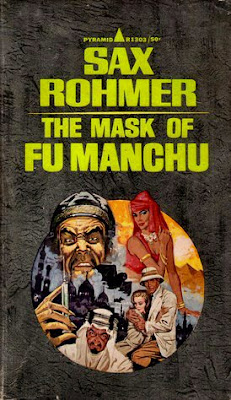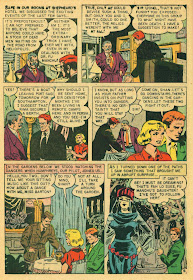Tuesday, April 16, 2013
The Mask Of Fu-Manchu
I spent a lovely day this weekend enjoying some warm spring weather and reading the latest Sax Rohmer novel from Titan Books, The Mask of Fu-Manchu published in 1932. The novel offers up a sweeping tale of murder, intrigue, and Oriental danger in the classic style. But as a Fu-Manchu novel, I have to say I was somewhat underwhelmed by this particular entry.
The Mask of Fu-Manchu has been made into a movie, a lurid extravaganza starring Boris Karloff in the title role and the alluring Myrna Loy as Fah Lo Suee, the Devil Doctor's daughter. This movie is such a notorious outing, brimming with sexual tension, that I somehow thought the novel might be just as potentially transgressive. What I found was the tamest Fu-Manchu novel I've yet read in the series.
In the original trio of novels produced during the WWI period and before, the myth of the Devil Doctor is growing, his role as the embodiment of the "Yellow Peril" giving the story a grim racist component that makes the whole work bristle with a potent tension. There's a lurid quality to the crimes perpetrated by Fu-Manchu that make the whole affair unsavory, but compelling nonetheless. I found that to be true to some extent in the first 1930's novel too, presenting a Doctor old and increasingly dangerous.
In this novel unfortunately, the Doctor is given a dose of youth thanks to his chemical canniness and somehow the depravity inherent in this schemes heretofore have been replaced by mere megalomania and somewhat routine criminality. Fu-Manchu wants to conquer the world again sure, but this time he does so by trying to awaken a Moslem uprising in the Middle East by finding the sword and mask of an infamous long-dead leader rumored to one day be resurrected, and this will in some way will redound to the benefit of all of Asia. He is opposed as usual by Sir Denis Nayland Smith who has quit Scotland Yard and our narrator Shan Greville, an archeologist who comes across as a bit of a shmuck. It's all a bit strained, but the idea seems to be that Europeans must now be on guard against the whole world of ethnically different peoples as Fu-Manchu broadens his appeal among all non-white societies. On the surface this seems more dangerous, but in reality it is such a cliche that it lacks the punch of the classic Yellow Peril menace. He wants to rule the world more it seems than he wants to change it.
Also the Devil Doctor seems significantly less "devilish" in this outing. He becomes a bit too polite and too predictable to be frightening in any real way. The ending in particular of this tale was disappointing as it suggests Fu-Manchu grudingly respects his opponents, which confuses me frankly since I find Shan not a very impressive type. There seems missing from his "respect" the venom which always in the past informed it. The fact is Fu-Manchu in this story appears to be less depraved and less of a challenge to the fundamental moral values of the classic Western society. He's reduced a bit to a mere canny master criminal.
Hopefully in the next installment the dangerous Devil Doctor will return in full force.
For now here is Avon comic book version of the Sax Rohmer novel, a surprisingly faithful adaptation of The Mask of Dr.Fu-Manchu. The story is pretty much all here, which says a lot about the relatively sedate content of the novel. You'll note it features the early artwork of the late great Wally Wood.
Rip Off
































I saw the movie as a preteen and it haunted me for years: the torment of the Bell; the silky malice of Karloff's Fu; the Art Deco operating theatre and the crocodile pit.
ReplyDeleteLove the movie. It's the very definition of "lurid". I didn't get to see it until a few years ago, but it is awesome. I just wish the novel had been as potent.
DeleteRip Off